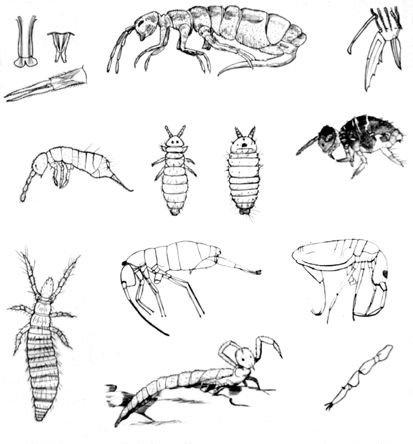Parainsecta
Springtails and Proturans


The Parainsecta (which may be a paraphyletic group) include a number of small, wingless uniramians, divided into two classes: the Collembola (springtails) depicted in the upper part of this drawing, and the Protura at the lower left and center. Unlike true insects, whose abdomen is always composed of 11 segments, collembolans have only six abdominal segments, and proturans have 9 to 12. The Collembola possess a jumping organ that fold back under the abdomen, the furcula - from which they have received their common name of "springtails." Members of both classes are small and inconspicuous, but may be quite common in leaf litter, in soil, or on moss.
Collembolans have the honor of being the oldest known hexapods (six-legged uniramians) in the fossil record, predating the oldest true insects. The Rhynie Chert, from near Aberdeen, Scotland, has yielded important fossils of very early land life in the Devonian, both plant and animal -- including Rhyniella praecursor, a springtail. Aside from this remarkable find, proturans have no known fossil record, and only a few collembolans are known as fossils, mostly from Oligocene amber.
Carpenter, F. M. 1992. Treatise on Invertebrate Paleontology. Part R. Arthropoda 4, Volume 3: Superclass Hexapoda. Geological Society of America and University of Kansas, Boulder, Colorado and Lawrence, Kansas.

More on springtails is available from the University of Delaware insect database. Or visit the Tree of Life, maintained at the University of Arizona, for more on collembolans and proturans.

